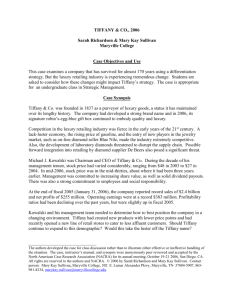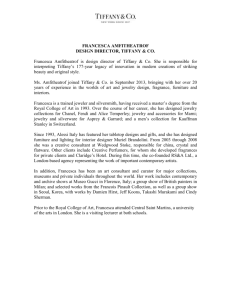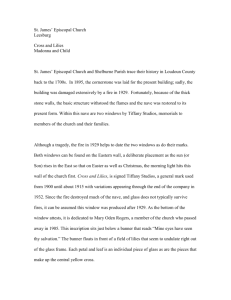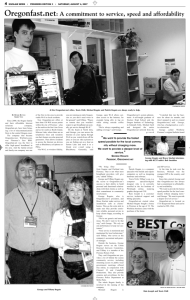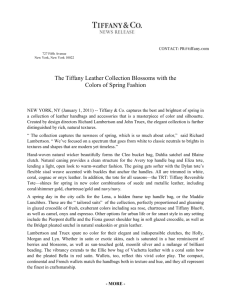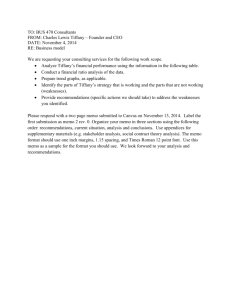Tiffany And Co. Competitive Analysis
advertisement
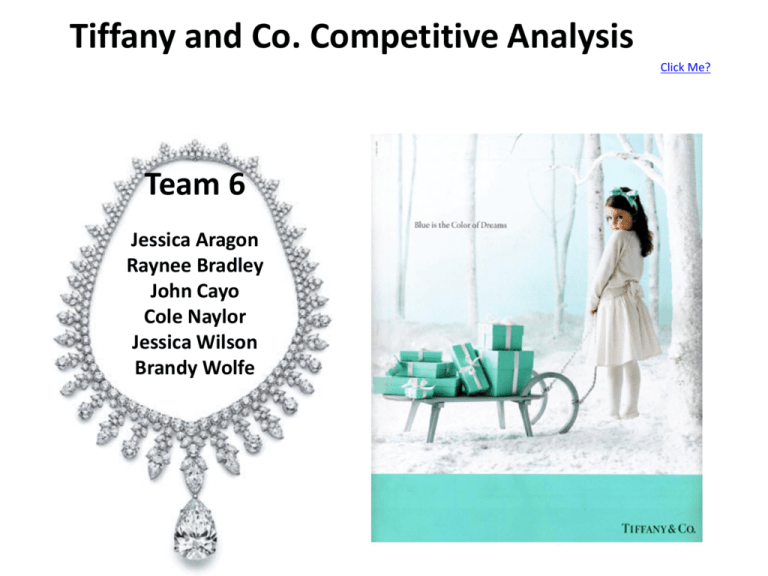
Tiffany and Co. Competitive Analysis Click Me? Team 6 Jessica Aragon Raynee Bradley John Cayo Cole Naylor Jessica Wilson Brandy Wolfe Tiffany and Co. • In New York City in 1837, Charles Lewis Tiffany and John F. Young founded Tiffany and Young, a store dedicated to selling stationery and costume jewelry. • In 1845, began selling “real” jewelry. • It was not until 1853 that the store became known as Tiffany and Company. • During the late 1940s it added silverware, timepieces, perfumes, and other luxury items. • Throughout history they have managed to solidify their position as the leading competitor in the jewelry industry through creating a brand that shows value, quality, superior design, and exclusivity. Tiffany and Co. • Strong brand name and customer loyalty. – Infamous Tiffany Blue Box • One of Tiffany’s main goals is to ensure the long-term integrity of the company’s brand by creating a “feel good” experience. • Mature stage of the product life cycle. • Experienced large growth for the past thirty years. – The jewelry industry relies heavily on consumer spending, which in turn relies on a strong economic climate. Tiffany and Co. • Even during this highly volatile economic downturn, Tiffany and Co. is a highly attractive company and the leading competitor. • The strong position that they have established in the marketplace is not likely to disappear, and it will only continue to grow once they counteract the changing environment with implementing a strategy that reiterates their founding vision. • According to Louis Cona, publisher of Vanity Fair, “There will always be a luxury consumer, and they’ll continue to spend whether there are wars or diseases or whatever.” Current Strategy • Launching new, lower-priced products to take advantage of the growing number of consumers demanding quality goods at lower prices. • Target: Middle income - introduce products with prices ranging from $100 to $250 • Affordable luxury and Exclusive luxury…Mix? • Must assure its affluent customers that the quality of its products and service has not lessened even though its brand has become more affordable. • Has created mass amounts of short term revenue, but in the long run it could be detrimental to the once timeless, exclusive brand. Accounting/Financial Strategy Accounting Criteria • Tiffany and Co. is consistently conservative in its financial and accounting practices. • As required by U.S. law, Tiffany’s employs GAAP accounting, but also maintains industry norms for choices not specified by GAAP. • Tiffany’s previously used the LIFO inventory method, but has recently switched over to the Average Cost method. – The majority of competitors use the FIFO method. • Tiffany’s follows the industry-wide trend of straight-line depreciation of assets. • Due to FAS 142, Tiffany’s reviews goodwill annually to check for any impairments which may have occurred. • Tiffany’s follows the point-of-sale revenue recognition principle. – This practice does not recognize revenues until an actual purchase has been made and maintained Accounting Flexibility • The use of GAAP practices allows for a great deal of flexibility in several areas. • The options available for inventory costing, depreciation, goodwill, and pension accounting provide companies with leverage and flexibility in their financial statements. Flexibility in Inventory • Flexibility in inventory costing can change margin, profits, and expenses. • Tiffany’s previously employed the LIFO costing method which creates the highest inventory expenses of the three methods. – This also portrayed lower profit margins and more conservative accounting • The switch from LIFO to Average Cost inflated profits by lowering inventory expenses. Flexibility in Pension Accounting • Pension accounting practices in the U.S. has been recently scrutinized. • In order for Tiffany and Co. to more accurately estimate pension expenses indices such as the Merrill Lynch yields reports are referenced. • Tiffany and Co. also uses what is know as the projected unit credit actuarial method for financial reporting of pension expenses. – This method involves the use of a certified actuary to estimate and attest to the estimated pension expense to be realized by a company, and is regarded to be the most accurate and reliable. Net Sales/ Net Receivables Net Sales/ Net Receivable Explained • Taking sales and dividing them by A/R finds the A/R Turnover Ratio. This gives the interested parties a more visible picture of how many sales are made on account while the rest are in cash. A higher ratio is ideal because it shows a company that receives cash instead of waiting on accounts to be realized. Tiffany’s ratio is underperforming compared to its competitors. This does not work in Tiffany’s favor because it shows a low cash flow from sales, which constricts the company’s flexibility in cash and drive potential investors away. Reasons for this low ratio is fewer customers coming in or not receiving payment of accounts as quickly as expected. Return on Equity ROE Explained • Tiffany and Co. shows not only a greater ROE than its competitors and the industry, but also a more steady ROE over the years. There are no drastic changes like those experienced by Zale’s and Tiffany’s continues to maintain strong numbers in the twenties and teens which portray high profit returns from the money invested by stockholders. This makes Tiffany’s attractive for investors. Gross Margin Gross Margin Explained • Gross margin is a useful tool for examining a company’s operating efficiency. Tiffany’s has a very strong and competitively high gross margin portraying that Tiffany’s is more capable of profiting off of each sale made than both its competitors and the industry as a whole. However, this added margin is most likely the result of price mark-ups. This is not necessarily a bad thing since most of the customers of Tiffany’s are willing to pay the extra price for the Tiffany’s brand name. Marketing & Advertising • Tiffany Blue – Robins egg blue box • Target market – Upper-middle to high income consumers • Advertisements • Pop culture • Something for everyone Working for Tiffany & Co. • Who they hire • What the employees are saying • Commitment to being environmentally and socially responsible Tiffany & Co. SWOT Analysis Strengths Weaknesses Strong direct selling strategy Strong brand name Broad offerings Strong balance sheet Decline in cash flows Lower returns and profit margins Struggling performance in Japanese market Opportunities Threats Expansion in retail outlets Increasing online sales Growth in men’s market New business venture Counterfeit goods Increasing rental rates in US Slowdown of US economy Competitor SWOT Blue Nile Strengths Weaknesses Strong direct selling strategy Strong balance sheet Growth of E-commerce Decline in cash flows Lower return and profit margins Limited offerings Lack of physical stores Opportunities Threats Expansion in retail stores Increasing online sales Increasing brand recognition Counterfeit goods Slowdown of US economy Bulgari Strengths Weaknesses Strong direct selling strategy Broad offerings Strong balance sheet Decline in cash flows Lower returns and profit margins Opportunities Threats Expansion in retail outlets Increasing online sales Increasing brand recognition Counterfeit goods Slowdown of US economy Key Success Factors and Core Capabilities • Key Success Factors – Introduction and execution of e-commerce – Understand economic conditions and reacting – Aspects of consumer spending • Core Capabilities – Ability to select and display high-end jewelry to create a sustainable advantage – Constantly strive towards innovation – Commitment to the highest standards for social and environmental responsibility Overlap of Tiffany’s key success factors and core capabilities Relative Competitive Strength How does Tiffany & Co. measure up against their competition? Resources • • • • Financial stability Large stores in expensive areas Store expansions here and abroad (206 locations) Famous designers Elsa Peretti Paula Picasso Frank Gehry Assets • Most valued assets is the Tiffany brand – others valuable assets include quality and reputation • Elegant perception of the brand makes price premiums possible • Will not compete on price Imitations • Many product styles are “imitated” but none are comparable in quality • Counterfeit goods (streets and eBay) • Tiffany Blue Box is non-imitable Substitutes • Other symbols of status and success: cars, clothing, cosmetics, hand bags, homes • The average Tiffany’s consumer is also purchasing beautiful homes and expensive cars. • “Superior race” that strives for elegance, quality, and exclusivity in all aspects of their lives. Relative Cost Position Cost Strategy • There are three types of cost strategy: – Cost Leadership – Differentiation – Focus • The main cost in the jewelry industry, and thus experienced by Tiffany and Co. is the cost of raw materials: diamonds, gold, platinum, etc. Differentiation or Focus? • Tiffany’s offers a broad product range to several types of markets. • Their main focus is in the fine jewelry and bridal markets. • The signature “blue box” which Tiffany’s is known for differentiates it from all other companies. • However, Tiffany’s is more focused on separate markets and target groups within them suggesting a more focused cost strategy. Cost Structure • Tiffany’s main source of capital is through external investors, not debt financing • As previously stated, the main cost is the cost of raw materials. – The strong-hold over diamonds by companies like DeBeers and Aber Corp. have forced Tiffany’s into long term contracts for raw materials purchasing. – This reliance on diamond is also placed on Tiffany’s competitors Inventory Costing • Tiffany’s used the LIFO method for inventory costing for years, but recently switched to the average cost method. • Most of the jewelry industry, and Tiffany’s main competitors use FIFO instead. – This inflates competitor financial statements by portraying a smaller number for inventory expenses Debt to Equity Ratio Debt to Equity Explained • Tiffany’s debt to equity ratio of 0.23 in 2005 shows that the company uses more equity, also known as investor capital, than debt to finance its activities. Related to competitors and the industry, Tiffany’s ratio is a little lower than average meaning that as a whole, the industry is still using a larger portion of equity financing than debt financing. Leverage Ratio Leverage Ratio Explained • The leverage ratio indicates how much a company has borrowed. Since Tiffany’s leverage ratio is not significantly high, the indication is that Tiffany’s has low borrowing. Competitors also have low leverage ratios. Once again, this places Tiffany’s in the middle of the industry mix with room for growth. Relative Cost Position • Tiffany and Co. has a strong cost position among its competitors. The main cost driver is reliant upon the supply of raw materials, but this is also true throughout the industry. The strategy that Tiffany’s employs to control its costs and financial distributions is very competitive, and it offers room for expansion and growth within the market, as well as into broader and newer markets. Identifying Strategic Issues and Problems Strategic Issues and Problems • The main strategic issues that Tiffany and Co. must consider involves: – the state of the economy – and whether they should take a short-term or long-term approach to stabilizing their current condition. • The best way to determine how to address these issues is through a scenario analysis. Scenario Analysis • A scenario analysis is basically a what-if analysis. • The purpose of this analysis is to allow improved decision-making by addressing all issues and giving full consideration of outcomes and their implications. • This will involve evaluating the current condition of the company’s external environment, consumer environment, and internal environment. The External Environment • The economy has been of increasing concern as it has continued to decline. • Tiffany & Co.’s sales have continued to decline, and now, as of the fourth quarter of 2009, their net income has plummeted 76 percent. • However, Tiffany’s has mentioned “robust sales in most global markets offset the sales decline” • Another factor of the external environment is the inflation on raw materials. The Consumer Environment • There are two main social classes, consisting of: – Upper class – Upper-Middle class or “aspirational buyers” • Missing segment of the consumer base. The Internal Environment • This consists of the inherent competencies of the firm and the structure of its internal systems and processes. – Core Competencies – Key success factors • For Tiffany & Co., the internal environment has created the foundation of its success. Realistic Options/Choices • Locked into the option of only making improvements in their same basic strategy. • There are two basic options: – Option 1: Broaden Scope Through LowerPriced Jewelry – Option 2: Focus on Brand Image and Exclusivity • Tiffany & Co. is known for being innovative, and this would be a good opportunity to differentiate themselves from their high-end discounting competitors. • Discounting a price is never an option for Tiffany’s • Tiffany’s could introduce more high quality, yet appropriately priced, lines of jewelry to accommodate this volatile time period. • This option focuses on stimulating short-term sales to stabilize the company during the recession. Advantages and Disadvantages • Advantages – Increases sales and market share – Preserves the missing segment of aspirational buyers – Stabilizes the company during the recession • Disadvantages – – – – Only a short-term fix May compromise the integrity of the brand Could drive away the upper-class consumers Creates long-term profit loss y • Instead of broadening their scope, this option proclaims that Tiffany’s should focus on building and maintaining their high-end identity. • This can be done through having consistent product assortments that are symbols of quality, prestige, and value. • This options focuses on maintaining long-term success and profitability. Thus, it requires riding out the recession. Advantages and Disadvantages • Advantages: – Consistent with the brand image – Maintains long-term success – Upholds the company’s “exclusive” reputation • Disadvantages: – Risk riding out the recession – Short-term loss of profits and market share Favorable Option • We feel that option 2 is the most favorable option for the company. • Recent results with Tiffany & Co have proven that lower-priced products compromise the integrity of their brand. ~ silver charm bracelet • These lower priced products are likely to alienate the jewelry firm’s older, wealthier, and more conservative clientele. In the end, it could possibly forever damage Tiffany’s timeless reputation and image for luxury. Strategy • Our strategy for Tiffany and Co. came down to one key factor that needs to be maintained: their exclusive brand. • Effective branding creates market resilience. • The Tiffany blue box and the Tiffany & Co. brand has developed into one of the best-known symbols for quality, prestige and value in retailing. • CEO Michael Kowalski states “We don’t plan any dramatic change in strategy. Like all good luxury brands, we manage this company from a very long-term point of view–we are certainly going to [continue to] do that.” • Tiffany’s needs to adapt while still holding on to their core value, which strengthens their brand image. Stick to what they do best! How to maintain their brand image? • Tiffany should devote a high amount of time and effort to its marketing and advertising strategies. • To help assist the performance of Tiffany’s brand image, Tiffany should continue emphasizing internet shopping, target demographics, and store growth. • Tiffany’s is a lifestyle; it is a luxurious, exclusive group of consumers. This needs to be preserved by bringing in loyal customer that can afford Tiffany’s quality jewelry. Tiffany and Co. • We believe that Tiffany and Co. should continue to emphasize their original vision and grow their timeless, legendary brand image. • A strong balance sheet, “real” assets, a visible global growth story, and long term market share opportunities further support this view. • Even with the current economic crisis, it is safe to say that the Tiffany and Co. will not fade away. Tiffany: Radiant Brilliance After all, diamonds will always be a girl’s best friend.
